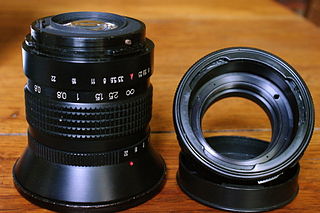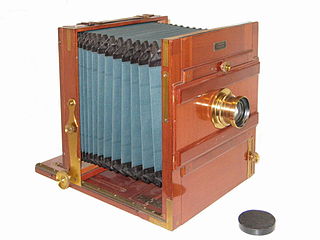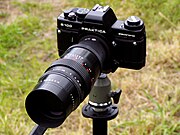History
In 1959 several Dresden camera manufacturers, among them VEB Kamerawerke Freital, were joined to create Volkseigener Betrieb Kamera- und Kinowerke Dresden, which was renamed in 1964 to VEB Pentacon Dresden. In 1968, VEB Feinoptisches Werk Görlitz was integrated into VEB Pentacon. Accordingly, the former Meyer-Optik Görlitz lenses were now renamed to ”Pentacon“ .
After German reunification in 1990 Pentacon, as with most East German companies, came to be possessed by the Treuhandanstalt (the federal board concerned with the privatisation of East German companies) and was selected for closure instead of sale. It was deemed that company was grossly inefficient, employing six thousand staff when it could have sufficed with one thousand, and selling its cameras at a loss. Liquidation began on October 2, 1990 (one day before official reunification), and production ceased on June 30, 1991. By then it had shed nearly three thousand employees to retain a total of 3331 - the next day all but 232 were laid off.
Investor Heinrich Manderman, who had previously been involved in resurrecting lensmaker Schneider Kreuznach, purchased the rights to the Pentacon brands and several portions of its assets, including the former military production building in Dresden. The company was re-established as Pentacon GmbH, a member of the Jos. Schneider group.
Production of cameras and lenses continues, but is now outsourced to South Korea.
Other parts of the former Pentacon company was sold to Noble and today belong to Kamera Werk Dresden, which, among other products, manufacture panoramic cameras under the Noblex brand, and cameras for industrial use under the Loglux brand.
Pentacon also produces scanner cameras. The latest model, the Scan 7000, was introduced at the photokina 2010 in Cologne, Germany. The Scan 7000 is operated with SilverFast and has a resolution of 20.000 × 20.000 pixels.

The Exakta was a camera produced by the Ihagee Kamerawerk in Dresden, Germany, founded as the Industrie und Handels-Gesellschaft mbH, in 1912. The inspiration and design of both the VP Exakta and the Kine Exakta are the work of the Ihagee engineer Karl Nüchterlein, who did not survive the Second World War.

Carl Zeiss AG, branded as ZEISS, is a German manufacturer of optical systems and optoelectronics, founded in Jena, Germany in 1846 by optician Carl Zeiss. Together with Ernst Abbe and Otto Schott he laid the foundation for today's multinational company. The current company emerged from a reunification of Carl Zeiss companies in East and West Germany with a consolidation phase in the 1990s. ZEISS is active in four business segments with approximately equal revenue in almost 50 countries, has 30 production sites and around 25 development sites worldwide.

Pentax Corporation was a Japanese camera and optical equipment manufacturer, and currently, it exists as the Pentax Life Care Business Division of Hoya's medical endoscope business, as well as the digital camera brand of Ricoh Imaging, a subsidiary of Ricoh.

Praktica was a brand of camera manufactured by Pentacon in Dresden in eastern Germany, within the GDR between 1949 and the German reunification in 1990. The firm Pentacon was divided in mainly two parts and sold after German reunification. Schneider Kreuznach and Noble bought parts of it. Pentacon is a Dresden-based company in the optical and precision engineering industry, which was at times a major manufacturer of photo cameras. The name Pentacon is derived on the one hand from the Contax brand of the Dresden Zeiss Ikon Kamerawerke and Pentagon, because a pentaprism for SLR cameras developed for the first time in Dresden has this shape in cross section. Today's PENTACON GmbH Foto- und Feinwerktechnik is still based in Dresden. It is part of the Schneider Group, Bad Kreuznach. Pentacon is the modern-day successor to Dresden camera firms such as Zeiss Ikon; for many years Dresden was the world's largest producer of cameras. Previous brands of the predecessor firms included Praktica, Exa, Pentacon, Zeiss Ikon, Contax, Ica, Ernemann, Exakta, Praktiflex, and many more.

Rollei was a German manufacturer of optical instruments founded in 1920 by Paul Franke and Reinhold Heidecke in Braunschweig, Lower Saxony, and maker of the Rolleiflex and Rolleicord series of cameras. Later products included specialty and nostalgic type films for the photo hobbyist market.
Kiev is a Soviet and Ukrainian brand of photographic equipment including cameras manufactured by the Arsenal Factory in Kyiv, Ukraine. The camera nameplates show the name "KIEV", with older cameras using "КИЕВ" or "КИЇВ" in Cyrillic.

Contax began as a German camera model in the Zeiss Ikon line in 1932, and later became a brand name. The early cameras were among the finest in the world, typically featuring high quality Zeiss interchangeable lenses. The final products under the Contax name were a line of 35 mm, medium format, and digital cameras engineered and manufactured by Japanese multinational Kyocera, and featuring modern Zeiss optics. In 2005, Kyocera announced that it would no longer produce Contax cameras. The rights to the brand are currently part of Carl Zeiss AG, but no Contax cameras are currently in production, and the brand is considered dormant.

Ihagee was a camera manufacturer based in Dresden, Germany. Its best-known product was the Exakta single-lens reflex camera.

Norita was a Japanese optical manufacturer. Founded in 1951 by Toshio Norita, it originally made lenses for binoculars but moved on to prisms and thence pentaprisms for SLR cameras.

The M42 lens mount is a screw thread mounting standard for attaching lenses to 35 mm cameras, primarily single-lens reflex models. It is more accurately known as the M42 × 1 mm standard, which means that it is a metric screw thread of 42 mm diameter and 1 mm thread pitch.

The history of the single-lens reflex camera (SLR) begins with the use of a reflex mirror in a camera obscura described in 1676, but it took a long time for the design to succeed for photographic cameras. The first patent was granted in 1861, and the first cameras were produced in 1884, but while elegantly simple in concept, they were very complex in practice. One by one these complexities were overcome as optical and mechanical technology advanced, and in the 1960s the SLR camera became the preferred design for many high-end camera formats.

The Pentacon Six is a single-lens reflex (SLR) medium format camera system made by East German manufacturer Pentacon from 1966 to 1992. The Six accepts lenses with the Pentacon Six mount, a breech-lock bayonet mount.

The Pentacon Six mount is a breech-lock bayonet lens mount originally used by several medium format single-lens reflex cameras from East Germany.
Carl Braun Camera-Werk of Nuremberg, Germany, or Braun, as it was more commonly called, was founded as an optical production house. It is best known for its 35mm film cameras named Paxette, and for slide projectors named Paximat.

The Reisekamera, meaning a "travel camera", is a large-format wooden bellows tailboard view camera of almost standardised design, unlike the much lighter and more flexible field camera, but not as cumbersome as the studio camera. A sturdy tripod is always brought along, but it might just as well be placed on a tabletop. It has equally sized rectangular front and back panels on a full-width double-extension baseboard that is hinged near the front. The front panel, holding the lens plate, has horizontal and vertical movements, while the back is tilt-suspended on brass standards running on brass tracks on either side of the baseboard, providing rack and pinion focusing on the film plane. An almost non-tapering calico double-extension bellows is employed; allowing the projected image to freely reach the photographic plate regardless of lens offset position. The camera folds flat, after the back panel is brought forward to the lens panel, by folding the hinged base board up, and thus conveniently protecting the focusing screen. For insertion of the wooden dark slide plate cassette, the hinged focusing screen is swung up and away. The Reisekamera was made available for several plate sizes; most common are the 13×18 cm, 18×24 cm and 24×30 cm versions. Shutter and lens were normally not part of the original delivery. However, some were made available with a spectacular focal-plane shutter, recognisable by the brass mechanisms either side of the back panel.

Kamera-Werkstätten Guthe & Thorsch (K.W.) was established 1919 in Dresden by Paul Guthe and Benno Thorsch, starting out manufacturing the Patent Etui plate camera. Ten years later came the roll film TLR Pilot Reflex and in 1936, the 6×6 SLR Pilot range. By that time, Benno Thorsch, the surviving partner from 1919, decided to immigrate to the United States and arranged with the US citizen Charles Noble to swap enterprises. Noble came to Germany and moved the factory to Niedersedlitz on the outskirts of Dresden, while Benno Thorsch in Detroit ran the acquired photo finishing business that was one of the largest in the USA. The new Kamera-Werkstätten AG, Niedersedlitz prospered, and in 1939 launched the 35mm SLR Praktiflex camera. The concept proved successful, and through continuous development, the Praktica name became one of the most popular 35mm SLR brands for several decades, beginning in the 1950s.

Kamera-Werkstätten Guthe & Thorsch was a photographic equipment manufacturer based in Dresden.

The Waggonbau Görlitz Corporation has built locomotives and rolling stock since 1849. They are best known for the double-deck rail cars that have been in production since 1935 in Görlitz, Germany. The Görlitz plants have been sold to Bombardier Transportation in 1998 making them available under the Bombardier Double-deck Coach brand. Since 2021 belongs to Alstom.

Meyer Optik Görlitz, originally Hugo Meyer & Co., was a former optical company from Görlitz in Germany. It was founded in 1896 by optician Hugo Meyer and businessman Heinrich Schätze. The company got off to a successful start with the development of the wide-angle Aristostigmat lens and the subsequent acquisition of Optical Institute Schulze and Billerbeck, the manufacturers of “Euryplan lenses”, as they were called at the time.





















